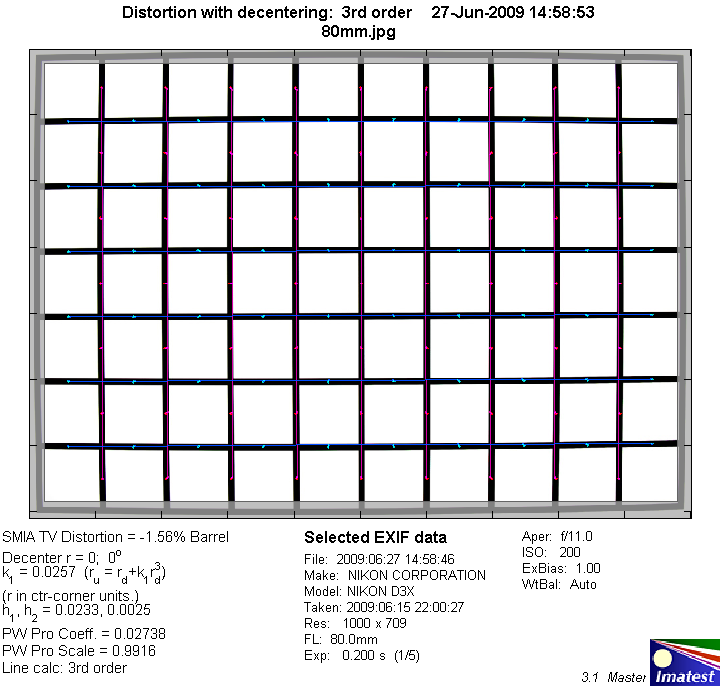|
Page 2 of 3

Distortion
The lens shows moderate barrel distortion at the short end, switching over to a small amount pincushion distortion at the opposite end of the zoom range. At medium focal lenght settings, the lens is practically free of distortion.
|
Move the mouse cursor over the focal length text marks below to observe the respective distortion
|
| 80mm |
135mm |
200mm |
|

|
The chart above has a real-world size of about 120x80cm.
Vignetting
Typical for a fast zoom lens, the amount of vignetting is somewhat pronounced at the largest aperture setting, but stopping down reduces the border light fall-off to usually irrelevant levels.
We're performing our vignetting analysis based on
(uncorrected) JPEGs straight from the camera. The JPG engine of the Nikon D3x features a rather flat
gradation curve, thus has a moderate contrast characteristic, resulting in comparatively low vignetting figures - the
corresponding Canon figures are roughly 40% higher due to the more
aggressive default contrast setting.

MTF (resolution)
At all focal length settings the image center delivers very good resolution wide open, which increases to excellent sharpness when stopped down.
At 80 mm the borders and corners are generally very good at all tested aperture settings. Towards longer focal lengths, the quality drops a little here at large apertures, but stopped down to f/5.6 or f/8 the borders and corners still reach very good resolution.
Please note that the MTF results are not directly comparable across the different systems!
Below is a simplified summary of the formal findings. The chart shows line widths
per picture height (LW/PH) which can be taken as a measure for sharpness.
If you want to know more about the MTF50 figures you may check out the corresponding
Imatest Explanations

Chromatic Aberrations (CAs)
Chromatic aberrations (color shadows at harsh contrast transitions) are somewhat pronounced with up to almost 2 pixels at the image borders at 80mm, but reduce to lower levels at longer focal lengths.
Please note that lateral CAs can easily be corrected in software or by the camera itself (most modern Nikon DSLRs remove CAs on-the-fly if you shoot JPGs).

Bokeh
Being a fast tele lens one of the lens' welcome abilities is to separate the main subject from the background, so rendering of out of focus areas is an important aspect.
The AF-S 80-200 delivers a generally very smooth bokeh at all focal lengths.
Thanks to 9 rounded aperture blades, background highlights remain circular throughout the whole aperture and focal range, except at the image borders where they are cut off due to mechanical vignetting. They show a smooth filling with almost no outlining.

Bokeh Fringing
Bokeh fringing (non-coinciding focal planes of the various colors) is a common issue with relatively fast glass. As you can
notice below, the halos have different colors - magenta (red + blue) in front the focus point
and green beyond. Truly "apochromatic" lenses don't show this kind of fringing but these lenses are very rare. Unlike lateral lateral CAs, bokeh fringing cannot easily be fixed in post processing.
At its longest focal length of 200 mm (which we used for the shots below) the lens shows a moderate amount of LoCAs wide open, which is considerably reduced by f/4 already and no longer field-relevant at f/5.6 and beyond.
|